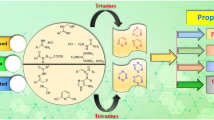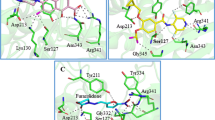Abstract
Biochemically active Cu(II) and Zn(II) complexes [CuL(ClO4)2(1) and ZnL(ClO4)2(2)] have been synthesized from N,N donor Schiff base ligand L derived from4,6-dichloropyrimdine-5-carboxaldehyde with 4-(2-aminoethyl)morpholine. The L, complexes 1 and 2 have been structurally characterized by elemental analysis, 1H-NMR, FTIR, MS, UV-Visible and ESR techniques. The results obtained from the spectral studies supports the complexes 1 and 2 are coordinated with L through square planar geometry. DFT calculations results supports, the ligand to metal charge transfer mechanism can occur between L and metal(II) ions. The antimicrobial efficacy results have been recommended that, complexes 1 and 2 are good anti-pathogenic agents than ligand L. The interaction of complexes 1 and 2 with calf thymus (CT) DNA has been studied by electronic absorption, viscometric, fluorometric and cyclic voltammetric measurements. The calculated Kb values for L, complexes 1 and 2 found from absorption titrations was 4.45 × 104, L; 1.92 × 105, 1 and 1.65 × 105, 2. The Ksv values were found to be 3.0 × 103, 3.68 × 103and 3.52 × 103 for L, complexes 1 and 2 by using competitive binding with ethidium bromide (EB). These results suggest that, the compounds are interacted with DNA may be electrostatic binding. The molecular docking studies have been carried out to confirm the interaction of compounds with DNA. Consequently, in vitro anticancer activities of L, complexes 1 and 2 against selected cancer (lung cancer A549, liver cancer HepG2 and cervical carcinoma HeLa) and normal (NHDF) cell lines were assessed by MTT assay.










Similar content being viewed by others
References
Jung Y, Lippard SJ (2007) Direct cellular responses to platinum-induced DNA damage. Chem Rev 107:1387–1407
Gracia MH, Morais TS, Florindo P, Piedade MFM, Moreno V, Ciudad C, Noe V (2009) Inhibition of cancer cell growth by ruthenium(II) cyclopentadienyl derivative complexes with heteroaromatic ligands. J Inorg Biochem 103:354–361
Wu CH, Wu DH, Liu X, Guoyiqibayi G, Guo DD, Lv G, Wang XM, Yan H, Jiang H, Lu ZH (2009) Ligand-based neutral ruthenium(II) arene complex: selective anticancer action. Inorg Chem 48:2352–2354
Kim E, Rye PT, Essigmann JM, Croy RG (2009) A bifunctional platinum(II) antitumor agent that forms DNA adducts with affinity for the estrogen receptor. J Inorg Biochem 103:256–261
Shebl M, Adly OMI, El-Shafiy HF, Khalil SME, Taha A, Mahdi MAN (2017) Structural variety of mono- and binuclear transition metal complexes of 3-[(2-hydroxybenzylidene)-hydrazono]-1-(2-hydroxyphenyl)-butan-1-one: Synthesis, spectral, thermal, molecular modeling, antimicrobial and antitumor studies, 1134:649–660
Pravin N, Kumaravel G, Senthilkumar R, Raman N (2017) Water-soluble Schiff base cu(II) and Zn(II) complexes:synthesis, DNA targeting ability and chemotherapeutic potential of cu(II) complex for hepatocellular carcinoma–in vitro and in vivo approach. Appl Organomet Chem 31:e3739. https://doi.org/10.1002/aoc.3739
Zhu T, Wang Y, Ding W, Xu J, Chen R, Xie J, Zhu W, Jia L, Ma T (2015) Anticancer activity and DNA-binding investigations of the cu(II) and Ni(II) complexes with coumarin derivative. Chem Biol Drug Des 85:385–393
Li Y, Yang Z, Zhou M, He J, Wang X, Wu Y, Wang Z (2017) Syntheses, crystal structures and DNA-binding studies of cu(II) and Zn(II) complexes bearing asymmetrical aroylhydrazone ligand. J Mol Struct 1130:818–828
Oehninger L, Rubbiania R, Ott I (2013) N-heterocyclic carbene metal complexes in medicinal chemistry. Dalton Trans 42:3269–3284
Kumar A, Sinha S, Chauhan PM (2012) Synthesis of novel antimycobacterial combinatorial libraries of structurally diverse substituted pyrimidines by three-component solid phase reactions. Bioorg Med Chem Lett 12:667–669
Baraldi PG, Pavani MG, Nunez M, Brigidi P, Vitali B, Gambari R, Romagnoli R (2002) Antimicrobial and antitumor activity of N-heteroimine-1,2,3-dithiazoles and their transformation in triazolo- imidazo- and pyrazolopyrimidines. Bioorg Med Chem 10:449–456
Nasr MN, Gineinah MM (2002) Pyrido [2,3-d]pyrimidines and pyrimido [50,40:5,6]pyrido[2,3-d]pyrimidines as new antiviral agents: synthesis and biological activity. Arch Pharm 335:289–295
Sondhi SM, Johar M, Rajvanshi S, Dastidar SG, Shukla R, Raghubir R, Lown JW (2001) Anticancer, anti-inflammatory and analgesic activity evaluation of heterocyclic compounds synthesized by the reaction of 4-isothiocyanato-4-methylpentan-2-one with substituted o-phenylenediamines, o-diaminopyridine and (un)substituted o-diamino pyrimidines. Aust J Chem 54:69–74
Gangjee A, Vidwans A, Elzein E, McGuire JJ, Queener SF, Kisliuk RL (2001) Synthesis, antifolate and antitumor activities of classical and nonclassical 2-amino-4-oxo-5- substitutedpyrrolo[2,3-d]pyrimidines. J Med Chem 44:1993–2003
Kumar N, Singh G, Yadav AK (2001) Synthesis of some new pyrido[2,3-d]pyrimidines and their ribofuranosides as possible antimicrobial agents. Heteroat Chem 12:52–56
Herbst RS, Heymach JV, Oreilly MS, Onn A, Ryan A (2007) Vandetanib (ZD6474): an orally available receptor tyrosine kinase inhibitor that selectively targets pathways critical for tumor growth and angiogenesis. Expert Opin Investig Drugs 16:239–249
Bayrak H, Demirbas A, Karaoglu SA, Demirbas N (2009) Synthesis of some new 1,2,4-triazoles, their Mannich and Schiff bases and evaluation of their antimicrobial activities. Eur J Med Chem 44:1057–1066
Kesavan MP, Vinoth Kumar GG, Dhaveethu Raja J, Anitha K, Karthikeyan S, Rajesh J (2017) DNA interaction, antimicrobial, antioxidant and anticancer studies on cu(II) complexes of Luotonin a. J Photochem Photobiol B 167:20–28
Revathi N, Sankarganesh M, Rajesh J, Dhaveethu Raja J (2017) Biologically active cu(II), co(II), Ni(II) and Zn(II) complexes of pyrimidine derivative Schiff base: DNA binding, antioxidant, antibacterial and in vitro anticancer studies. J Fluoresc 27:1801–1814
Rajesh J, Gubendran A, Rajagopal G, Athappan PR (2012) Synthesis, spectra and DNA interactions of certain mononuclear transition metal(II) complexes of macrocyclic tetraaza diacetyl curcumin ligand. J Mol Struct 1010:169–178
Perontsis S, Hatzidimitriou AG, Papadopoulos AN, Psomas G (2016) Nickel-diflunisal complexes: synthesis, characterization, in vitro antioxidant activity and interaction with DNA and albumins. J Inorg Biochem 162:9–21
Babu B, Nandhini T, Vaidyanathan VG, Nair BU (2016) Studies on interaction of Cr(III) polypyridyl complexes with DNA. Inorg Chem Commun 73:124–128
Gubedran A, Kesavan MP, Ayyanaar S, Dhaveethu Raja J, Athappan PR, Rajesh J (2017) Synthesis and characterization of water-soluble copper(II), cobalt(II) and zinc(II) complexes derived from 8-hydroxyquinoline-5-sulphonic acid: DNA binding and cleavage studies. Appl Organomet Chem 31:e3708
Mahendiran D, Senthil Kumar R, Viswanathan V, Velmurugan D, Rahiman AK (2016) Targeting of DNA molecules, BSA/c-met tyrosine kinase receptors and anti-proliferative activity of bis(terpyridine)copper(ii) complexes. Dalton Trans 45:7794–7814
Galal SA, Hegab KH, Kassab AS, Rodriguez ML, Kerwin SM, El-Khamry AMA, El Diwani HI (2009) New transition metal ion complexes with benzimidazole-5-carboxylic acid hydrazides with antitumor activity. Eur J Med Chem 44:1500–1508
Thati B, Noble A, Creaven BS, Walsh M, McCann M, Devereux M, Kavanagh K, Egan DA (2009) Role of cell cycle events and apoptosis in mediating the anti-cancer activity of a silver(I) complex of 4-hydroxy-3-nitro-coumarin-bis(phenanthroline) in human malignant cancer cells. Eur J Pharmacol 602:203–214
Zhang K, Zhu L, Liu YT, Wu ZY, Yan CW (2015) Synthesis and crystal structure of new dicopper(II) complexes having asymmetric N,N,-bis(substituted)oxamides with DNA/protein binding ability: In vitro anticancer activity and molecular docking studies. J Photochem Photobiol B 149:129–142
Arun T, Subraminian R, Raman N (2016) Novel bio-essential metal based complexes linked by hetercyclic ligand: synthesis, structural elucidation, biological evaluation and docking analysis. J Photochem Photobiol B 154:67–76
Silverstein RM, Bassler GC, Morrill TC (1981) Spectrometric identification of organic compounds, fourth ed., New York
Thomas M, Nair MKM, Radhakrishnan RK (1995) Rare earth iodide complexes of 4-(2′,4′-dihydroxyphenylazo) antipyrine. Synth React Inorg Met-Org Chem nano-Met Chem 25:471–479
Raman N, Dhaveethu Raja J, Sakthivel A (2008) Template synthesis of novel 14-membered tetraazamacrocyclic transition metal complexes: DNA cleavage and antimicrobial studies. J Chil Chem Soc 53:1568–1571
Abd-Elzaher MM, Labib AA, Mousa HA, Moustafa SA, Ali MM, El-Rashedy AA (2016) Synthesis, anticancer activity and molecular docking study of Schiff base complexes containing thiazole moiety. Beni Suef 5:85–96
Raman N, Sakthivel A, Dhaveethu Raja J, Rajesekaran K (2008) Designing, structural elucidation and comparison of the cleavage ability of metal complexes containing tetradentate Schiff bases 1. Russ J Inorg Chem 53:213–219
Dutta RL, Syamol A (1993) Elements of Magnetochemistry, second ed., New Delhi
Gaussian 09, Revision A 02, Frisch MJ, Trucks GW, Schlegel HB, Scuseria GE, Robb MA, Cheeseman JR, Scalmani G, Barone V, Mennucci B, Petersson GA, Nakatsuji H, Caricato M, Li X, Hratchian HP, Izmaylov AF, Bloino J, Zheng G, Sonnenberg JL, Hada M, Ehara M, Toyota K, Fukuda R, Hasegawa J, Ishida M, Nakajima T, Honda Y, Kitao O, Nakai H, Vreven T, Montgomery JA, Jr, Peralta JE, Ogliaro F, Bearpark M, Heyd JJ, Brothers E, Kudin KN, Staroverov VN, Kobayashi R, Normand J, Raghavachari K, Rendell A, Burant JC, Iyengar SS, Tomasi J, Cossi M, Rega N, Millam JM, Klene M, Knox JE, Cross JB, Bakken V, Adamo C, Jaramillo J, Gomperts R, Stratmann RE, Yazyev O, Austin AJ, Cammi R, Pomelli C, Ochterski JW, Martin RL, Morokuma K, Zakrzewski VG, Voth GA, Salvador P, Dannenberg JJ, Dapprich S, Daniels AD, Farkas O, Foresman JB, Ortiz JV, Cioslowski J, Fox DJ, Gaussian, Inc., Wallingford CT, 2009
Sankarganesh M, Adwin Jose P, Dhaveethu Raja J, Kesavan MP, Vadivel M, Rajesh J, Jeyamurugan R, Senthil Kumar R, Karthikeyan S (2017) New pyrimidine based ligand capped gold and platinum nano particles: synthesis, characterization, antimicrobial, antioxidant, DNA interaction and in vitro anticancer activities. J Photochem Photobiol B 176:44–53
Liang JW, Wang Y, Du KJ, Li GY, Guan RL, Ji LN, Chao H (2014) Synthesis, DNA interaction and anticancer acitivity of copper(II) complexes with 4′-phenyl-2,2′:6′2″-terpyridine derivatives. J Inorg Biochem 141:17–27
Mathan Kumar S, Kesavan MP, Vinoth Kumar GG, Sankarganesh M, Chakkaravarthi G, Rajagopal G, Rajesh J (2018) New heteroleptic Zn(II) complexes of thiosemicarbazone and diimine co-ligands: structural analysis and their biological impacts. J Mol Struct 1153:1–11
Li Z, Wang J, Ren T, Zhang L, Shi J, Song C, Wang R, Chang J (2016) Influence of the methyl position on the binding of 5-epitaiwaniaquinone G to HSA investigated by spectrofluorimetry and molecular modeling. Med Chem Res 25:1009–1019
Sankarganesh M, Rajesh J, Vinoth Kumar GG, Vadivel M, Mitu L, Senthilkumar R, Dhaveethu Raja J (2018) Synthesis, spectral characterization, theoretical, antimicrobial, DNA interaction and in vitro anticancer studies of cu(II) and Zn(II) complexes with pyrimidine-morpholine based Schiff base ligand. J Saudi Chem Soc 22:416–426
Li Z, Wang Z, Wang N, Han X, Yu W, Wang R, Chang J (2018) Identification of the binding between three fluoronucleoside analogues and fat mass and obesity-associated protein by isothermal titration calorimetry and spectroscopic techniques. J Pharm Biomed Anal 149:290–295
Ren T, Wang Z, Zhang L, Wang N, Han W, Wang R, Chang J (2017) Study of the binding between Camptothecin analogs and FTO by spectroscopy and molecular docking. J Fluoresc 27:1467–1477
Carter MT, Rodriguez M, Bard AJ (1989) Voltammetric studies of the interaction of metal chelates with DNA. 2. Tris-chelated complexes of cobalt(III) and iron(II) with 1,10-phenanthroline and 2,2′-bipyridine. J Am Chem Soc 111:8901–8911
Zhang SS, Niu SY, Qu B, Jie GF, Xu H, Ding CF (2005) Studies on the interaction mechanism between hexakis(imidazole) manganese(II) terephthalate and DNA and preparation of DNA electrochemical sensor. J Inorg Biochem 99:2340–2347
Gaur R, Khan RA, Tabassum S, Shan P, Siddiqi MI, Mishra L (2011) Interactions of a ruthenium(II)-chalcone complex with double stranded DNA: spectroscopic, molecular docking and nuclease properties. J Photochem Photobiol B 220:145–152
Acknowledgements
The authors acknowledge the Department of Science and Technology (DST)-Science and Engineering Research Board (SERB-Ref.No.: SR/FT/CS-117/2011 dated 29.06.2012), Government of India, New Delhi for the financial support and express their sincere thanks to Managing Board, Dean, Principal, Head and staff members, Chemistry Research Centre, Mohamed Sathak Engineering College, Kilakarai for providing research facilities..
Author information
Authors and Affiliations
Corresponding author
Electronic supplementary material
ESM 1
(DOCX 648 kb)
Rights and permissions
About this article
Cite this article
Sankarganesh, M., Dhaveethu Raja, J., Adwin Jose, P.R. et al. Spectroscopic, Computational, Antimicrobial, DNA Interaction, In Vitro Anticancer and Molecular Docking Properties of Biochemically Active Cu(II) and Zn(II) Complexes of Pyrimidine-Ligand. J Fluoresc 28, 975–985 (2018). https://doi.org/10.1007/s10895-018-2261-0
Received:
Accepted:
Published:
Issue Date:
DOI: https://doi.org/10.1007/s10895-018-2261-0




